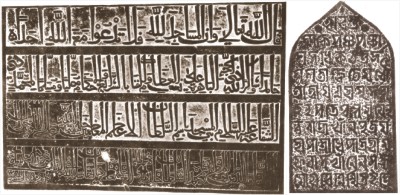Seminar
New light on some early inscriptions of Bengal
Cultural Correspondent
Dr Enamul Haque, chairperson and academic director of the International Centre for Study of Bengal Art (ICSBA), is a man with a mission -- to promote and popularise the ancient and medieval art of Bangladesh and eastern India. And there is a crying need for such promotion since none of the 78 universities in Bangladesh offer any specialised subjects related to the ancient periods of art forms such as sculpture, architecture, epigraphy, numismatics, painting and minor arts such as calligraphy and ivory work. Thanks to a handful of mostly septuagenarian scholars such as Haque, there is a rekindling of interest in this vital epoch in art history.Seen in this light, ICSBA's 32nd seminar, titled 'New Light on Some Early Muslim Inscriptions of Bengal' on July 6 is indeed worthy of mention. At centre stage was Dr Mohammad Yusuf Siddiq from the Department of History and Islamic Civilisation, University of Sharjah, UAE. The scholar, who is conversant in 10 languages, gave an excellent presentation of the history of early inscriptions, the globalisation of the art and some case studies. Amplifying on the importance of inscription in reconstructing history, Dr Siddiq pointed out "Inscription is an important art. It throws a mirror on the past. Through inscriptions, one learns about history, rulers, titles used by rulers, policies and trends." In Siddiq's view, "The Arabic and Persian inscriptions of medieval Bengal are aesthetically superb, especially those made between the 13th to 16th century. They are unmatched in terms of their exquisite beauty." Siddiq also talked about the 'globalisation in culture.' As he maintained, an inscription in Gaur (the ancient Muslim capital of Bengal, on the north western border of West Bengal and Bangladesh), was akin to many found all over the Islamic world. Presiding over the seminar was Dr AKM Yaqub Ali, emeritus professor in the Department of Islamic History and Culture of Rajshahi University. While extending kudos to Dr Siddiq for his innovative paper, he questioned some of the dates of the inscriptions. While a lot of the seminar's proceedings was double Dutch to some of the audience, on the whole it was a catalyst for spreading awareness of the ancient art of inscription in Bengal. Said Perveen Hasan, professor in the Department of Islamic History and Culture, Dhaka University. "All the inscriptions were derived from buildings. The presentation was scholarly and gave an idea of the richness of building activity during the Sultanate period. However, I have one reservation: the seminar could have been more organised in the sense that book references could have been given." To ICSBA goes the credit for organising a seminar on a relatively unexplored subject. In the words of Haque, "The Centre's raison d'etre is to promote and develop study programmes on Bengal art. The organisation is dedicated to investigation in the fields of archaeology, architecture, sculpture, painting, epigraphy, numismatics, religion, ethnography and the spectrum of folk and decorative arts." Haque certainly has the credentials to spearhead the organisation--he is the founder and former director general of the National Museum. In addition, he was secretary-in-charge, Ministry of Culture. ICSBA has held 32 seminars and six bi-annual international congresses on Bengal art. The last such conference was held in Ranchi last year, while the seventh will be held in February next year at Bogra. The upcoming meet will attract eminent scholars from all over the world. The Centre also brings out an annual Journal of Bengal Art. And Haque has done more than dole out esoteric, armchair sermons. ICSBA has opened the Institute of Bengal Art in Banani to train specialists in ancient and medieval art of Bengal. Already five students have taken admission to do their master's in Bengal art. "Our aim is to infuse new blood in this field," says an upbeat Haque.
|

Mandra inscription of Jalal al-din Muhammad in the Bangladesh National Museum (Left), Dhorail (Dinajpur) Sanskrit inscription of Ghiath al-din Mahmud Shah in the Varendra Research Museum, Rajshahi |